From The CRPG Addict
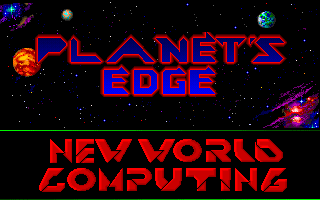 |
| Note that the game’s title screen does not technically exclude the possibility of returning from this point. |
United States
New World Computing (developer and publisher)
Because it took me so long to get Planet’s Edge up and running, I had time to do more background research first–the kind of thing that I usually save for the “Summary and Rating” entry. I learned from Wikipedia that the game grew out of a desire to merge the boardgame Star Fleet Battles with an RPG. I learned from an RPG Codex interview that the developers wanted to put “Might and Magic in space.” Nowhere did the authors report a direct influence from any other game, so it was a surprise when I fired it up and found myself looking at . . . Starflight. It has the same type of base where you enter different buildings to accomplish similar tasks, the same type of ship with commands arranged by “station,” the same approach to galactic exploration, the same variety of weird alien races to meet, and the same take on combat. Sure, it does some things differently, but the core of the game was clearly cribbed from Starflight. Was it so hard for the developers just to admit “we wanted our own version of Starflight“?
There is some confusion about a couple of elements in the header. First, the title. My policy is that a game’s “official” title is the best two out of three on the manual cover, box cover, and in-game title screen. If all three conflict, I go with the in-game title screen. In the case of Planet’s Edge, the box includes a subtitle (The Point of No Return) that both the manual and in-game screen lack. Second, a while back, commenter shankao made a case for the game being released in 1992 instead of the official copyright date (and MobyGames date) of 1991. His argument is based on the fact that no reviews appeared for the game until comparatively late in 1992. I didn’t find any conclusive evidence, but I decided to accept shankao’s argument and move the game to 1992.
 |
| Judging by the animate intro, the backstory is “some guy escapes a cruiser by shooting a guard and stealing a ship.” |
Planet’s Edge is set in 2045. Humanity has colonized the Moon and has seeded Earth’s orbit with various space stations, satellites, and other craft. The denizens of these orbiting habitats become humanity’s only survivors when the rest of the planet is sucked into a “space-time warp.” The warp is the result of an electro-magnetic burst fired from an extraterrestrial craft, although it is unknown whether it was accidental or deliberate (a Chinese space station had disobeyed U.N. orders and fired missiles at the craft just before the event). Either way, Earth’s gravitational influence somehow remains, keeping the Moon and satellites in orbit.
 |
| The Luna Base commander gives orders. |
Commander Mason Polk of Luna Base takes charge of humanity’s remnant. Without Earth’s resources, the base will run out of food and life support within a few years, so time is crucial. From the crashed alien spaceship, scientists recover the device that caused the disaster. They call it the “Centauri Device” and identify eight parts that they need to reconstruct it and possibly reverse its effects: a N.I.C.T.U. (but no K.L.A.A.T.U. or B.A.R.A.D.A.), an Algocam, a K-Beam, a Harmonic Resonator, a Mass Converter, a Gravitic Compressor, Krupp Shields, and Algiebian Crystals. How they came up with these names is left a bit vague. A ship dubbed the Ulysses is commissioned to scour the galaxy for these items and otherwise try to find out why the extraterrestrial ship visited and destroyed Earth. It’s a little unclear how we suddenly have the ability to travel outside our solar system, or given that we have said ability, why there’s a time limit on survival at Luna Base.
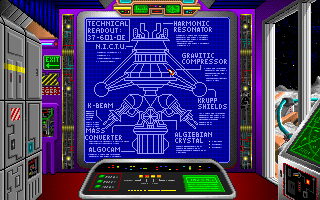 |
| I wonder if K-beams glitter in the dark. |
Gameplay begins at Luna Base, where the player can visit the shipyards (build and modify ships), the warehouse (offload cargo), the crew quarters (view and clone crewmembers), the research lab (check on progress with the Centauri Device), and the launchpad (head out into the universe). The items that you can build for your ship or characters depend on the resources that you bring back from other places–resources such as organics, heavy metals, alien isotopes, and rare elements.
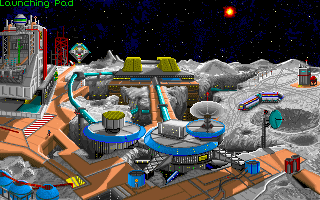 |
| Luna Base and its various buildings. |
The crew consists of four fixed characters. The pilot is William Robert Dean from Tulsa, Oklahoma. Osai Lin Tsakafuchi from Tokyo is the ship’s physician and chief scientist. Engineering duties are handled by Nelson T. Ngatadatu of Babaishanda, New Gwelo (a fictional place, but “Gwelo” is a place name in Zimbabwe). The combat specialist (both ground and flight) is Katya A. Mershova from Muntenia, Romania. Each character occupies one of the ship’s four stations, some doing double duty if anyone dies. Each character has fixed attributes in body, intelligence, agility, and luck, as well as fixed skills like “Leadership,” “Light Weapons,” “First Aid,” and “Computers.” I don’t know whether these attributes or skills are capable of developing, but I don’t see any sign that they are.
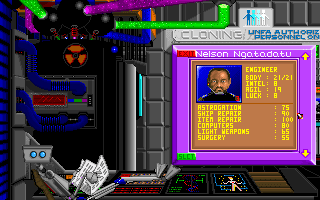 |
| Attributes for my engineer. |
Each character has a personal inventory, drawn from the supplies on Luna Base or found in the galaxy. The first thing I did was give them all flak jackets and weapons.
I found the ship modification process confusing enough that I decided to save it for later and just blasted off in the default ship. Once in space, commands are organized among four “consoles”: navigation, weapons, engineering, and science. For instance, to communicate with another ship, you select the “Weapons” console (counterintuitively) and then “Communicate.” To heal crewmembers, you select “Science” and then “Heal Crew.” There are far less than 26 commands, so I don’t understand why each couldn’t have its own key. However, Planet’s Edge does a little better than previous games using this structure by at least allowing you to hit single keys on the submenus rather than arrowing through them. Also, a few very common commands like Navigation | Starmap and Navigation | Enter Orbit can be called from the main view with individual keys, without having to go into the stations first.
 |
| I couldn’t make heads or tails of this screen. |
Moving around is a combination of elements seen in Starflight and Star Control II. As you fly away from a planet, the map’s scale changes to show a larger area. As you enter a star system, it changes to show a smaller area. When you’ve locked onto a planet, you O)rbit it, at which point you can S)can it for information or B)eam down if it’s appropriate. (There’s no landing craft, just a transporter.) Making things a little difficult is that the planets continually whiz around their stars, unrealistically fast, so it’s tough to identify which ones you’ve already approached.
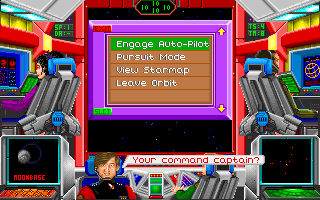 |
| Note how the navigator turns and looks at me while waiting for my order. |
I guess the player is kind of an invisible “fifth” crewmember. I base this on the fact that, according to his mission directives, he’s expressly forbidden to beam down with the rest of the crew. Also, when you’re activating the consoles in the ship, each of the crewmembers turns and looks at you, as if you’re sitting in a central chair. Despite this, you don’t get to name yourself or anything.
A map accompanying the game shows Earth’s solar system (“Sol”) at the center of a galaxy occupying coordinates from -64 to 64 on two axes. Sol is the point of convergence of eight “sectors” which grow outwards from the center like irregular pie wedges: Alnasl, Ankaq, Zaurak, Alhena, Algieba, Caroli, Izar, and Kornephoros. (Most of these are actual stars). There are a handful of systems at the fringes of the map that occupy no sector. It’s not really clear at the outset of the game whether the sector designations are geographic or political. Either way, note that the names of the missing parts suggest that we’ll find one part per sector.
I had a few false starts as I got used to navigation. Alpha Centauri is so close that it’s easy to blow past it on your way out of the solar system. I got killed three times in a row by hostile aliens who either attacked immediately or demanded cargo I didn’t have. I haven’t even begun to figure out ship combat. Since you can’t save in space, I kept restarting on Luna Base and having to try again.
 |
| Meanwhile, my crew is saying, “Oh my god! It’s an alien!” |
On the fourth try, I took things more slowly and explored the solar system before leaving it, although it appears you cannot land on any of its planets (which makes sense).
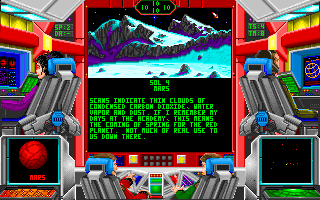 |
| Mars can be scanned but not visited. |
I then carefully made my way to Centauri. The first planet, Centauri Prime, was too inhospitable to land. The second wasn’t a planet but an “alien outpost.” When I scanned it for information, the computer called it the “Omegan Outpost” and said that it was a “contact point for observers who were assisting with the failed Centauri Drive experiment.” I guess we know all these things because of data recovered from the crashed alien ship.
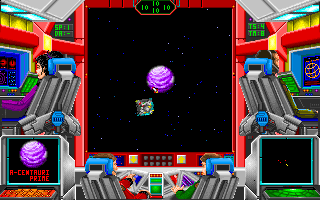 |
| Orbiting Centauri Prime. It’s a nice looking planet, but we can’t do anything there. I was hoping we’d meet Londo. |
The four expendable crewmembers beamed down and were immediately attacked by robots firing laser guns. Combat in the game is turn-based and like nothing that New World has developed before. It is perhaps most like Ultima VI, occurring within the main exploration window and using a targeting cursor to attack particular enemies. In fact, once combat was over, I found that regular exploration was also a lot like Ultima VI. As the leader moves, the other characters kind of organize themselves around him or her. You can switch between lead characters with the number keys (although there’s no “solo mode”) and do other common things like L)ook, T)alk to NPCs, and do a variety of things with inventory items. You can’t manipulate the environment to the same extent as Ultima VI, and (annoyingly) you can’t move on the diagonal, but nonetheless, by including this level of ground exploration and combat, New World has definitely gone a step beyond Starflight and Star Control II, even if the rest of the game seems similar.
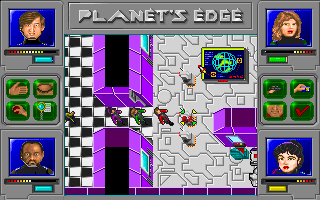 |
| Combat with robots in the outpost. |
A door led from the surface of the planet to the interior of the “welcome station,” where a friendly message invited us to browse various newscasts. As we moved from room to room, we faced several more combats, and I had to use medpacks (which we found strewn around the area) several times. We also found some better armor than we were wearing (kevlar) and some extra weapons.
 |
| A character inventory. |
We ran into an android who somewhat explained the situation: the station had been attacked by unknown aggressors who stole “various tactical data about the sectors.” Another android offered that the disappearance of Earth was “a tragic accident” and he encouraged us to continue our quest to find the various pieces of the Centauri Device. He specifically recommended going to Algieba Sector since “there’s a part that is named after one of that sector’s stars, after all.”
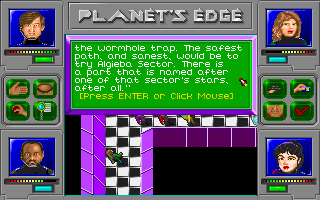 |
| But . . . Earth scientists named that part! They don’t know where it really comes from! |
Beneath a plaque labeled “Sector Izar,” we saw an image of a spacecraft that looks a lot like the extraterrestrial ship that visited Earth. A recorded message was saying that “something is malfunctioning with the drive” and “the experiment may have been sabotaged.” The overwhelming suggestion is that Earth’s disappearance was an accident, but we still don’t know what the aliens were trying to accomplish.
There were a couple of alien newscasts to watch. One suggested some kind of war developing in Sector Caroli. Another reported on a “white hole”–a kind of space volcano–forming in Sector Zaurak. Unforutnately, they were just text; they didn’t show anything, so we couldn’t see what type of alien they were talking about.
I was happy to find that you can save while on “away missions” and that you can turn off the relentless soundtrack with ALT-M. The rest of the sound effects are okay, except that when you view inventory, there’s an annoying and unnecessary “ding” as you move from one inventory item to another. Scrolling through a lot of them sounds like you’re demanding a bride and groom to kiss. On the positive side, every item seems to have a unique description, which I always think is cool.
 |
| I confess I don’t understand this, though. Wouldn’t the adjustment have to be on every cartridge? |
In the final room we explored, an android gave us a key that would unlock the various “android heads” strewn around the base. There were eight heads, each offering information on one or more of the galaxy’s eight sectors. Some of them were explicit about the technology and military level of these sectors, I guess suggesting a rough order of exploration. From lowest to highest, these are:
- Sector Algieba, where the Algiebian Empire has a low level of technology. This is the second explicit suggestion to go there first.
- Sector Zaurak, ruled by the “Rana Collective,” which controls the resources and means of production and thus has kept development at a minimum.
- Sector Kornephoros, settled by refugees fleeing oppressive governments in Sectors Izar and Ankaq. Their technology is mostly good, but inconsistent because it is based on scavenging.
- Sector Caroli. The android says that at the end of something called the Grand Survey, Sector Caroli was reserved for “recreation and housing for lower tech societies.” There, I’ll find Oortizam Labs and the Life Gallery. The only native species is the Eldarin.
- Sector Alhena has no government. Two races called the Evian and the Scroe are in a war for its resources, while a race called the Dhoven tries to negotiate. It is a mix of mid- and high-tech ships and weapons.
- Sector Ankaq, ruled by a planet called Shadowside, has a high level of technology.
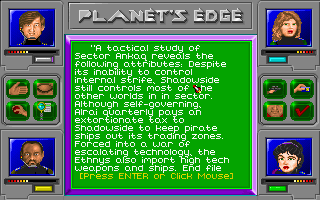 |
| The android head’s rundown on Ankaq. |
- Sector Izar is where Centauri and the station itself are located. The android warns against penetrating further into the sector because the OMEGA (unsure whether this is the race or the name of an organization) is capable of easily destroying everyone but the Ominar.
- Sector Alnasl, ruled by the Ominar. Lately, they have been reporting bouts of insanity and mass violence, and other races are advised to keep away. “These developments,” the head noted, “may well be connected to the disaster of the Sol Experiment.”
If this really is an exploration order, it’s too bad that the developers included it instead of encouraging the more open-exploration approach of both Starflight and Star Control II, not to mention previous New World games. Thus, I decided to defy it by heading direclty for Alnasl, one of the farthest stars in Sector Alnasl. I made it there with no problem, but when I arrived, a scaled alien told me that I was in violation of some “space conducts mandate” and refused to allow me to contact the single space station orbiting the star. I never figured out how this resolved because I had to take a break to reconcile my bank statement with Quicken, and Quicken decided it needed to update and took over my screen with its request for administrative rights, and whatever I did to make my DOSBox sessions survive such screen changes was undone when I restored the default configuration to play Planet’s Edge. (In its default configuration, DOSBox always crashes for me any time anything causes a major screen change, including unplugging or plugging in an extra monitor, opening or clsoing the laptop, and getting a demand for administrative privileges.) Thus, when I reloaded, I was back on the Centauri outpost. I guess this is a good place to end for now.
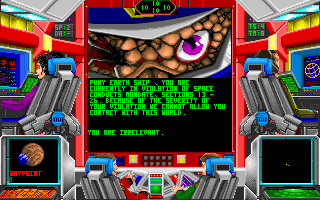 |
| If I’m “irrelevant,” why don’t you let me land? |
So far, it’s a decent game that evokes the best of Starflight and Star Control II, although I suspect the alien interactions are going to be less interesting and I worry that the blatantly suggeted exploration order will be essentially required. I also think it’s too bad that New World, which has a lot of experience in more traditional RPGs, didn’t bring more of their mechanics to character development and space combat. But it’s early. We’ll see how it goes.
*****
Time so far: 3 hours
Original URL: http://crpgaddict.blogspot.com/2020/03/game-361-planets-edge-1992.html
